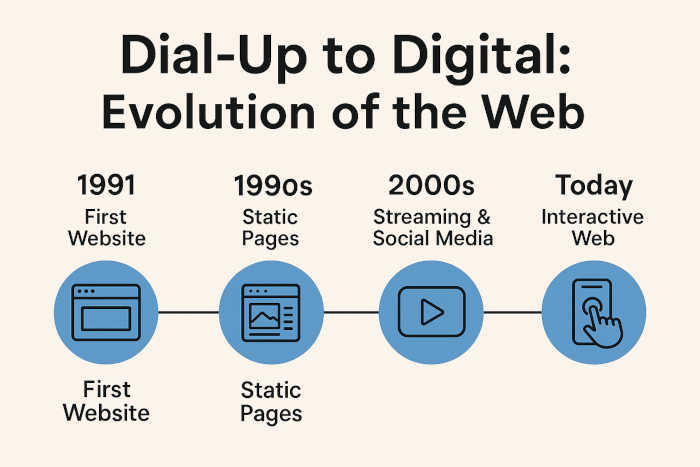As an Amazon Associate, I earn from qualifying purchases. Privacy Policy / Terms
Ever notice how traditional ads just don’t work anymore? You skip YouTube ads, block pop-ups, and toss junk mail straight into the trash. You’re not alone. Most people do the same thing.
Smart businesses have figured this out. Instead of shouting at you with ads, they’re having conversations. They share helpful tips, answer your questions, and solve your problems. That’s content marketing in action.
Think of it like this: Would you rather listen to a pushy salesperson or get advice from a helpful friend? Content marketing turns businesses into that helpful friend who actually cares about your problems.
What is Content Marketing?
Content marketing is simply sharing useful stuff with people who might buy from you someday. No hard selling. No pushy tactics. Just helpful information that makes their lives easier.
Here’s how it works in real life. Let’s say you own a plumbing business. Instead of buying expensive ads that people ignore, you create YouTube videos showing how to fix common leaks. People watch because they need help. They remember you when they need a real plumber.
You’re not trying to trick anyone. You’re genuinely helping people solve problems. Some viewers will call you for bigger jobs they can’t handle themselves. Others will recommend you to friends who need plumbing work.
The beauty is that helpful content keeps working long after you create it. That YouTube video about fixing leaks will help people for years. Each new viewer becomes a potential customer. Your Google Analytics will show steady traffic growth from content that’s already published.
Most people research everything before buying. They read reviews, watch videos, and ask friends for advice. Content marketing meets them during this research phase. You become their trusted source instead of just another product or service they might consider.
What Does a Content Marketer Do?
Content marketers are like helpful translators. They take complex business stuff and turn it into useful information that regular people actually want to read.
Their day starts with research. They dig into customer questions, complaints, and feedback. What problems keep coming up? What confuses people the most? This research becomes their content roadmap.
Planning takes up a big chunk of their time. They create schedules for blog posts, social media content, and email campaigns. Good content marketers map out content that helps people at different stages. Someone just discovering a problem needs different information than someone ready to buy.
Writing happens in many formats. Blog posts explain complex topics. Social media content shares quick tips. Email newsletters keep people engaged between visits. Video scripts turn written ideas into visual content that reaches different learning styles.
Promotion is half the job. Creating great content means nothing if nobody sees it. Content marketers share posts across social media platforms, optimize for search engines, and build email lists of interested people.
Measuring results keeps everything on track. They watch website traffic, social shares, and lead generation. Google Analytics shows which content brings in the most visitors. This data guides future content decisions.
Working with other teams makes content stronger. Sales teams share common customer questions. Customer service knows recurring problems. Product teams explain new features. All this input creates content that actually helps real customers.
What is an Example of Content Marketing?
Let’s look at some real businesses that turned content marketing into serious money makers.
The Home Depot knows its customers hate home improvement projects going wrong. So they created thousands of YouTube videos showing exactly how to install flooring, fix plumbing, and build decks. They don’t spend time talking about why their lumber is better than that of their competitors. Instead, they save you from calling an expensive contractor.
When your kitchen faucet starts leaking at midnight, you search YouTube for help. You find a Home Depot video that walks you through the fix step by step. Problem solved. Next time you need supplies for a bigger project, guess where you’re shopping?
Dollar Shave Club understood that buying razors was annoying and expensive. Their first video didn’t explain blade technology or shaving science. Instead, they made fun of the whole overpriced razor industry while promising cheap, quality razors delivered to your door. That single video got 27 million views and built a company worth over a billion dollars.
Local restaurants use content marketing without even knowing it. They post pictures of their food on Instagram and Facebook. Sharing recipes and cooking tips. They show behind-the-scenes content of chefs preparing meals. None of these posts says “come eat here tonight,” but they make you hungry and curious about the food.
Fitness trainers build their businesses by giving away workout tips. They post exercise videos, nutrition advice, and motivation on social media content platforms. People follow them for free information. Some followers eventually hire them as personal trainers or buy their workout programs.
Local mechanics share car maintenance tips on TikTok and YouTube. They show you how to check your oil, jump a dead battery, or know when your brakes need replacing. These videos help car owners save money on simple fixes. When something breaks that they can’t handle, guess who they call?
The pattern is always the same. Help people solve problems. Share your knowledge freely. Build trust over time. When people need professional help with bigger problems, they remember who helped them learn the basics.

What Are the 3 C’s of Content Marketing?
The three C’s keep your content marketing focused and effective. Think of them as guardrails that prevent you from creating random stuff nobody wants.
Content means creating stuff people actually find useful. Sounds obvious, right? But most businesses create content about what they want to sell instead of what customers want to learn.
Good content answers real questions your customers ask. It solves problems they face every day. It explains confusing topics in simple terms. The best content makes people think, “This is exactly what I needed to know.”
Research what your audience cares about. Check online forums where they hang out. Look at comments on competitor posts. Pay attention to customer service questions. This research reveals topics that will genuinely help your audience.
Context means being in the right place at the right time with the right message. Think of it like this: you wouldn’t wear flip-flops to a wedding or post vacation photos during a work meeting. Your content needs to match where people are in their journey.
If someone just realized their roof is leaking, they would look for different information than someone comparing roofing contractors. The leaky roof person wants to know, “Is this an emergency?” The comparison shopper wants to know “Who’s reliable and affordable?”
Different platforms have different vibes, too. Facebook posts can be chatty and personal. LinkedIn needs to sound more professional. TikTok thrives on quick, entertaining content. Instagram lives for eye-catching photos and stories.
Consistency builds trust over time. People need to know they can count on you for regular, helpful information. Sporadic posting confuses audiences and weakens your authority.
Set a realistic publishing schedule and stick to it. It is better to post once per week consistently than to post daily for a month, then disappear for two months. Your audience will develop habits around your content schedule.
Brand consistency matters just as much as publishing consistency. Your voice, style, and values should remain recognizable across all content and platforms. People should instantly know your content even without seeing your logo.
Building Your Content Marketing Strategy
Start by really understanding who you’re trying to help. Create detailed pictures of your ideal customers. What problems keep them awake at night? What questions do they ask Google at 2 AM? Where do they go for advice?
Don’t guess at these answers. Talk to actual customers. Send surveys. Check your customer service logs. Read reviews of your competitors. This research prevents you from creating content nobody wants.
Plan your content around your business goals. Want more leads? Create content that showcases your expertise. Want to reduce customer service calls? Write detailed how-to guides. Want to launch a new product or service? Develop educational content that explains the problem it solves.
Mix up your content formats to reach different people. Some folks love detailed blog posts. Others prefer quick videos. Busy people might listen to podcasts during commutes. Visual learners need infographics and charts.
Your social media content should complement your blog posts, not compete with them. Use social platforms to share highlights, ask questions, and start conversations. Drive traffic back to your website, where you can capture leads.
Email marketing keeps you connected between blog posts. Send weekly newsletters with your best content. Create email sequences that educate new subscribers about your industry. Email gives you direct access to interested people.
Track everything from day one. Set up Google Analytics to monitor website traffic. Use social media analytics to see which posts get the most engagement. Create simple spreadsheets to track leads from different content pieces.
Don’t expect overnight success. Content marketing builds momentum slowly but creates lasting results. A blog post published today might attract customers for years. Your Google Analytics will show this compound growth over time.
Getting Started Right Now
Pick three topics you know really well. These should be problems you solve for customers every day. Write blog posts explaining these topics in simple terms. Pretend you’re talking to a smart friend who knows nothing about your industry.
Start with one piece of content per week. Quality beats quantity every time. One helpful blog post performs better than five boring ones. Focus on making each piece genuinely useful.
Repurpose your content across different formats. Turn a blog post into a social media content series. Create an infographic highlighting the main points. Record a podcast episode expanding on the topic.
Engage with people who comment on your content. Answer questions. Thank people for sharing. Show that real humans work at your business. This personal touch builds stronger connections than corporate responses.
Connect your content to your business goals. Include subtle calls-to-action that invite people to learn more. Offer free consultations, downloadable guides, or email newsletters. Make it easy for interested readers to take the next step.
Be patient but persistent. Content marketing works like compound interest. Early efforts might feel slow, but results accelerate over time. Businesses that stick with content marketing for 12-18 months see dramatic improvements in website traffic and lead generation.
All of this can sound overwhelming while you’re trying to run your business. Remember that many companies hire content marketers who handle all this stuff consistently. Sometimes it’s worth focusing on what you do best and letting pros handle the content creation.
Remember that content marketing is about building relationships, not making quick sales. Focus on helping people solve problems. Trust develops naturally when you consistently provide value without asking for anything in return.
Your customers will appreciate this helpful approach. They’ll remember you when they’re ready to buy. Better yet, they’ll recommend you to friends facing similar problems. That’s how content marketing turns one helpful blog post into years of new business.
Views Expressed Disclaimer
The views, opinions, and information presented in this article are for informational purposes only and do not necessarily reflect the official policies or positions of Cleveland Computer Guy. While every effort has been made to ensure accuracy, Cleveland Computer Guy is not liable for any errors, omissions, or decisions made based on the content provided. Readers are encouraged to consult professionals for specific advice or assistance related to their unique circumstances.







